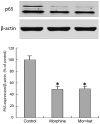Effect of morphine and a low dose of ketamine on the T cells of patients with refractory cancer pain in vitro
- PMID: 31516618
- PMCID: PMC6732974
- DOI: 10.3892/ol.2019.10750
Effect of morphine and a low dose of ketamine on the T cells of patients with refractory cancer pain in vitro
Abstract
The combination of morphine and ketamine is considered safe and efficacious in many patients. However, a considerable number of immunomodulatory effects have been reported to be produced by both morphine and ketamine. The aim of the present study was to assess the direct effect of morphine and a low dose of ketamine on the T cells of patients with refractory cancer pain in vitro. Venous blood was obtained from patients with refractory cancer pain and peripheral blood mononuclear cells were isolated using the Ficoll-Hypaque density gradient method. Anti-CD3 beads were used to isolate T cells by positive selection. Subsequently, the T cells were treated with vehicle, 200 ng/ml of morphine or 200 ng/ml of morphine + 100 ng/ml ketamine for 24 h, following which the cells were stimulated with anti-CD3 and anti-CD28. Flow cytometric analysis of CD3+ T cells, and interleukin (IL)-2 and interferon (IFN)-γ in the supernatant, reverse transcription-quantitative PCR analysis for the detection of IL-2 and IFN-γ and western blotting for the detection of p65 nuclear factor (NF)-κB were performed. In vitro, the CD4+ and CD8+ T cell counts, CD4+/CD8+ ratio, secretion of IL-2 and IFN-γ in the supernatant, mRNA expression levels of IL-2 and IFN-γ and expression of p65 NF-κB were significantly decreased following treatment with morphine and morphine + ketamine, compared with results in the control group (all P<0.05). However, there was no significant difference between treatment with morphine and that with morphine + ketamine. Treatment with morphine + ketamine in vitro decreased the immune functions of patients with refractory cancer pain, although the effect of treatment with morphine and a low dose of ketamine did not differ significantly from that with morphine treatment alone.
Keywords: T cells; cancer pain; interferon-γ; interleukin-2; ketamine; morphine; nuclear factor-κB.
Figures




Similar articles
-
Morphine in Combination with Ketamine Improves Cervical Cancer Pain and Suppresses Immune Function via the JAK3/STAT5 Pathway.Pain Res Manag. 2022 Apr 21;2022:9364365. doi: 10.1155/2022/9364365. eCollection 2022. Pain Res Manag. 2022. PMID: 35492074 Free PMC article. Clinical Trial.
-
Ketamine, as adjuvant analgesics for patients with refractory cancer pain, does affect IL-2/IFN-γ expression of T cells in vitro?: A prospective, randomized, double-blind study.Medicine (Baltimore). 2017 Apr;96(16):e6639. doi: 10.1097/MD.0000000000006639. Medicine (Baltimore). 2017. PMID: 28422864 Free PMC article. Clinical Trial.
-
[Interleukin-12 restores and promotes the T-cell immune function inhibited by 5-fluorouracil].Ai Zheng. 2007 Aug;26(8):801-8. Ai Zheng. 2007. PMID: 17697537 Chinese.
-
Increased in vitro induced CD4+ and CD8+ T cell IFN-gamma and CD4+ T cell IL-10 production in stable relapsing multiple sclerosis.Int J Neurosci. 1997 Aug;90(3-4):187-202. doi: 10.3109/00207459709000638. Int J Neurosci. 1997. PMID: 9352427 Review.
-
Ketamine Protocol for Palliative Care in Cancer Patients With Refractory Pain.J Adv Pract Oncol. 2015 Nov-Dec;6(6):555-61. Epub 2015 Nov 1. J Adv Pract Oncol. 2015. PMID: 27648345 Free PMC article. Review. No abstract available.
Cited by
-
Sufentanil postoperative analgesia reduce the increase of T helper 17 (Th17) cells and FoxP3+ regulatory T (Treg) cells in rat hepatocellular carcinoma surgical model: A randomised animal study.BMC Anesthesiol. 2020 Aug 26;20(1):212. doi: 10.1186/s12871-020-01129-0. BMC Anesthesiol. 2020. PMID: 32847505 Free PMC article.
-
Morphine in Combination with Ketamine Improves Cervical Cancer Pain and Suppresses Immune Function via the JAK3/STAT5 Pathway.Pain Res Manag. 2022 Apr 21;2022:9364365. doi: 10.1155/2022/9364365. eCollection 2022. Pain Res Manag. 2022. PMID: 35492074 Free PMC article. Clinical Trial.
-
Perioperative Ketamine and Cancer Recurrence: A Comprehensive Review.J Clin Med. 2024 Mar 26;13(7):1920. doi: 10.3390/jcm13071920. J Clin Med. 2024. PMID: 38610685 Free PMC article. Review.
-
Electroacupuncture Attenuates Neuropathic Pain in a Rat Model of Cervical Spondylotic Radiculopathy: Involvement of Spinal Cord Synaptic Plasticity.J Pain Res. 2023 Jul 18;16:2447-2460. doi: 10.2147/JPR.S415111. eCollection 2023. J Pain Res. 2023. PMID: 37483411 Free PMC article.
-
The Effect of Ketamine on the Immune System in Patients with Treatment-Resistant Depression.Int J Mol Sci. 2025 Aug 3;26(15):7500. doi: 10.3390/ijms26157500. Int J Mol Sci. 2025. PMID: 40806626 Free PMC article.
References
LinkOut - more resources
Full Text Sources
Other Literature Sources
Research Materials
